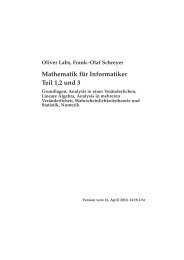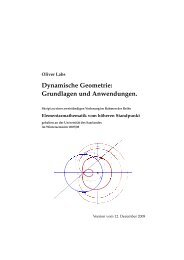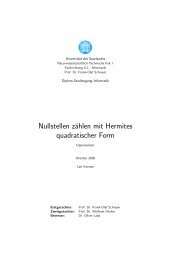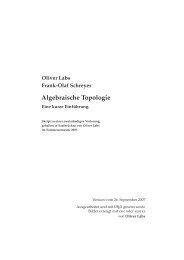Automated Generation of Kempe Linkages for ... - Alexander Kobel
Automated Generation of Kempe Linkages for ... - Alexander Kobel
Automated Generation of Kempe Linkages for ... - Alexander Kobel
You also want an ePaper? Increase the reach of your titles
YUMPU automatically turns print PDFs into web optimized ePapers that Google loves.
2 Basic <strong>Linkages</strong><br />
2.4 Angle Adder and Multiplicator<br />
We finish the presentation <strong>of</strong> the basic linkworks with two constructions on angle<br />
operations. In particular, we show that linkage designs include all necessary tools to<br />
implement the Z-module structure <strong>of</strong> angles.<br />
2.4.1 The Angle Adder<br />
A common task in linkage design is the addition <strong>of</strong> a (finite) number <strong>of</strong> angles. This<br />
can easily be achieved by inductively adding two angles by means <strong>of</strong> an angle adder<br />
consisting <strong>of</strong> distance copiers:<br />
Suppose we are given two angles ∡AOB and ∡CO ′ D. W.l.o.g. we can assume<br />
|OA| = |OB| = |O ′ C| = |O ′ D|; otherwise, we use plat<strong>for</strong>ms to constrain the links<br />
accordingly. We then attach two distance copiers to move CO ′ D such that the image<br />
<strong>of</strong> O ′ C is OA, yielding ∡CO ′ D = ∡C ′ O ′′ D ′ = ∡AOD ′ , and now use another distance<br />
copier to move |AB| to D ′ T such that AB is rotated by the angle ∡AOD ′ = ∡CO ′ D.<br />
Since we demanded the lengths <strong>of</strong> the legs to be equal, both AB and AD ′ are chords<br />
in a circle with center O. There<strong>for</strong>e, ∡AOB + ∡CO ′ D = ∡AOB + ∡AOD ′ = ∡AOT.<br />
2.4.2 The Angle Multiplicator<br />
Now suppose we want to construct an angle multiplicator, i.e. a mechanism to multiply<br />
an angle by an integer. Again, we can assume both legs to share the same lengths, so<br />
we can use a distance copier in the same manner to double, triple, . . . the angle.<br />
However, there is an easier approach to solve this special case, shown in figure 2.6.<br />
Here OADB and OBEC are antiparallelograms; the links satisfy |OA| · |OC| = |OB| 2 ⇔<br />
|OA|<br />
= |OB|<br />
|OB| |OC| .<br />
Of course we may not allow |OA| = |OB| in this setting, which leads to the degenerate<br />
position D = 0. This again is not a real restriction, since we can employ plat<strong>for</strong>ms to<br />
get distinct lengths <strong>of</strong> the legs. In general, we will have to do so anyway, because we<br />
have to guarantee the ratio <strong>of</strong> the bar lengths.<br />
Since |OA| , OADB is similar to OBEC, yielding ∡AOB = ∡BOC and thus<br />
= |OB|<br />
|OB| |OC|<br />
∡AOC = ∡AOB + ∡BOC = 2∡AOB. Iterating the construction, we can get a n times<br />
angle multiplicator <strong>for</strong> arbitrary, but fixed n ∈ N.<br />
<strong>Kempe</strong> [Kem76] uses the term angle reversor to call the multiplicator, because ∡BOA =<br />
−∡COB; thus the mechanism also allows to change the orientation <strong>of</strong> arbitrary angles.<br />
Together with the angle adder, we are able to subtract angles. As a side remark, which<br />
12






